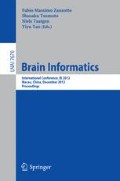Abstract
Computational models of cognitive processes are usually developed as separate components. The importance of the interactions among these models has been widely disregarded. In recent years, research on the brain information processing has focused on the interrelationships among cognitive functions, providing a wealth of evidence capable of informing the development of more integrative computational models of cognition. In this paper, we present a brain-inspired computational model of emotion and attention interaction. This model addresses some aspects of the interplay between these two processes and is developed to be included in cognitive architectures of intelligent agents. Simulations based on the dot-probe paradigm are carried out to validate the proposed model.
Access this chapter
Tax calculation will be finalised at checkout
Purchases are for personal use only
Preview
Unable to display preview. Download preview PDF.
References
Baluch, F., Itti, L.: Mechanisms of top-down attention. Trends in Neurosciences 34(4), 210–224 (2011)
Becker-Asano, C., Wachsmuth, I.: Affective computing with primary and secondary emotions in a virtual human. Autonomous Agents and Multi-Agent Systems 20(1), 32–49 (2010)
Bee, N., Falk, B., André, E.: Simplified facial animation control utilizing novel input devices: a comparative study. In: Proceedings of the 14th International Conference on Intelligent User Interfaces, pp. 197–206. ACM, New York (2009)
Bisley, J.W., Mirpour, K., Arcizet, F., Ong, W.S.: The role of the lateral intraparietal area in orienting attention and its implications for visual search. European Journal of Neuroscience 33(11), 1982–1990 (2011)
Engel, S., Zhang, X., Wandell, B.: Colour tuning in human visual cortex measured with functional magnetic resonance imaging. Nature 388(6637), 68–71 (1997)
Fredrickson, B.L., Branigan, C.: Positive emotions broaden the scope of attention and thought-action repertoires. Cognition & Emotion 19(3), 313–332 (2005)
Freese, J.L., Amaral, D.G.: Neuroanatomy of the primate amygdala. In: Whalen, P.J., Phelps, E.A. (eds.) The Human Amygdala, pp. 3–42. The Guilford Press (2009)
Frijda, N.: The Emotions. Cambridge University Press (1986)
Itti, L., Koch, C., Niebur, E.: A model of saliency-based visual attention for rapid scene analysis. IEEE Transactions on Pattern Analysis and Machine Intelligence 20(11), 1254–1259 (1998)
Leventhal, A.G.: The Neural Basis of Visual Function: Vision and Visual Dysfunction. CRC Press (1991)
Machado, H., Rafal, R.: Strategic control over saccadic eye movements: Studies of the fixation offset effect. Attention, Perception, & Psychophysics 62(6), 1236–1242 (2000)
MacLeod, C., Mathews, A., Tata, P.: Attentional bias in emotional disorders. Journal of Abnormal Psychology 95(1), 15–20 (1986)
Öhman, A., Flykt, A., Esteves, F.: Emotion drives attention: Detecting the snake in the grass. Journal of Experimental Psychology 130(3), 466–478 (2001)
Phelps, E.A.: Emotion and cognition: Insights from studies of the human amygdala. Annual Review of Psychology 57, 27–53 (2006)
Randall, W., Hill, J.: Modeling perceptual attention in virtual humans. In: Proceedings of the 8th Conference on Computer Generated Forces and Behavioral Representation (1999)
Russell, J.A.: Core affect and the psychological construction of emotion. Psychological Review 110(1), 145–172 (2003)
Taylor, J.G., Fragopanagos, N.F.: The interaction of attention and emotion. Neural Networks 18(4), 353–369 (2005)
Vuilleumier, P.: How brains beware: neural mechanisms of emotional attention. Trends in Cognitive Sciences 9(12), 585–594 (2005)
Author information
Authors and Affiliations
Editor information
Editors and Affiliations
Rights and permissions
Copyright information
© 2012 Springer-Verlag Berlin Heidelberg
About this paper
Cite this paper
Barriga, S.D., Rodríguez, LF., Ramos, F., Ramos, M. (2012). A Brain-Inspired Computational Model of Emotion and Attention Interaction. In: Zanzotto, F.M., Tsumoto, S., Taatgen, N., Yao, Y. (eds) Brain Informatics. BI 2012. Lecture Notes in Computer Science(), vol 7670. Springer, Berlin, Heidelberg. https://doi.org/10.1007/978-3-642-35139-6_23
Download citation
DOI: https://doi.org/10.1007/978-3-642-35139-6_23
Publisher Name: Springer, Berlin, Heidelberg
Print ISBN: 978-3-642-35138-9
Online ISBN: 978-3-642-35139-6
eBook Packages: Computer ScienceComputer Science (R0)

